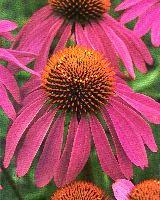 The Herb Research Foundation:
Herb Information Greenpaper
The Herb Research Foundation:
Herb Information Greenpaper
 The Herb Research Foundation:
Herb Information Greenpaper
The Herb Research Foundation:
Herb Information Greenpaper
 Echinacea
EchinaceaEchinacea, the purple coneflower, is the best known and researched herb for
stimulating the immune system. Thousands of Europeans and Americans use echinacea
preparations against colds and flu, minor infections, and a host of other major
and minor ailments. This native American herb has an impressive record of laboratory
and clinical research. Thousands of doctors currently use echinacea for treating
infectious diseases.
![]() Colds, coughs and flu and other upper
respiratory conditions
Colds, coughs and flu and other upper
respiratory conditions
![]() Enlarged lymph glands, sore throat
Enlarged lymph glands, sore throat
![]() Urinary tract infections
Urinary tract infections
![]() Other minor infections
Other minor infections
![]() May help combat herpes and candida
May help combat herpes and candida
![]() Wounds, skin regeneration and skin infections
(external use)
Wounds, skin regeneration and skin infections
(external use)
![]() Psoriasis, eczema and inflammatory skin
conditions (external use)
Psoriasis, eczema and inflammatory skin
conditions (external use)
Echinacea has a rich tradition of use by North American Plains Indians who used it medicinally more than any other plant. It was prominent in modern American medicine in the early 20th Century, and was discovered by Europeans, who have used it extensively since the 1930s. Today millions of Europeans use echinacea as their primary therapy for colds, flus, infections, and for general immune-boosting effects.
Echinacea increases the "non-specific" activity of the immune system. In other words, unlike a vaccine which is active only against a specific disease, echinacea stimulates the overall activity of the cells responsible for fighting all kinds of infection. Unlike antibiotics, which are directly lethal to bacteria, echinacea makes our own immune cells more efficient in attacking bacteria, viruses and abnormal cells, including cancer cells.
Echinacea facilitates wound healing, lessens symptoms of and speeds recovery from viruses. Anti-inflammatory effects make it useful externally against inflammatory skin conditions including psoriasis and eczema. It may also increase resistance to candida, bronchitis, herpes, and other infectious conditions.
| Clinical (human) research | |
| Laboratory research | |
| History of use / Traditional use | |
| Safety record | |
| International acceptance | |
|
Stars indicate level of knowledge on a scale from 0 - 5 |
|
Over 500 scientific studies have documented the chemistry, pharmacology, and clinical applications of echinacea. The most consistently proven effect of echinacea is in stimulating phagocytosis, that is encouraging white blood cells and lymphocytes to attack invading organisms. Specific actions:
Clinical Study: an extract of echinacea showed an increase of 50%-120% in immune function over a 5 day period (Jurcic, et al. 1989).
Clinical Study: an extract of echinacea significantly increased the resistance to flu and reduced the symptoms of lymph gland swelling, inflamed nasal passages and headache (Braunig, et al. 1992).
Clinical Study: Of 4500 patients with inflammatory skin conditions, including psoriasis, 85% were cured with topical applications of echinacea salve (Wacker & Hilbig, 1978).
Laboratory Study: Human white blood cells, stimulated by echinacea extract increased phagocytosis (consumption) of yeast cells by 20-40% compared to controls. (Wagner and Proksch 1985)
Echinacea has an excellent safety record and is very well tolerated by most people. There is no known toxicity. Echinacea should not be used in progressive systemic and auto-immune disorders such as tuberculosis, leicosis, connective tissue disorders, collagenosis and related diseases such as lupus, according to the German Kommission E. Its use in AIDS or opportunistic infections in AIDS patients is controversial.
Echinacea root is the part which has been used historically in European and American herbalism. Today nearly all parts of the plant are used, including the root, leaves, flowers, and seeds. Echinacea is available commercially in a number of forms - dried root or herb, liquid extract, powder, capsules and tablets, and creams and gels. Echinacea preparations are approved drugs in European countries. The officially recommended usage levels, and those used in research studies are:
Usage recommendations are from the British Herbal Pharmacopoeia and official sources from Germany (Kommission E and Standardzulassung).
With long-term use, echinacea appears to lose effectiveness. Maximum periods of continuous use: 6 - 8 weeks. Echinacea is not a substitute for other medical interventions in rapidly accelerating infections. If the condition persists or worsens, seek medical advice. Many serious medical conditions are not appropriate for self-diagnosis or self-medication and require the supervision of qualified health care providers. Use caution when practicing self-care.
Echinacea, Nature's Immune Enhancer by Stephen Foster. Healing Arts Press, 1991.
Echinacea, the Immune Herb by Christopher Hobbs. Botanica Press, 1990.
Botanical Influences on Illness by Melvyn Werbach and Michael Murray. Third Line Press, 1994. See chapters
on Cancer, Candidiasis, Immunodepression, Infection, Wound Healing.
Herbal Medicine by Rudolf Weiss. AB Arcanum, 1988.
British Herbal Pharmacopeia, 1992.
Kommission E Monographs: Echinacea. Kooperation Phytopharmaka, , Germany.
Jurcic, et al. Zeitschrift fur Phytotherapie 10 (2), 1989.
Braunig, et al. Zeitschrift fur Phytotherapie 13: 7-13, 1992.
Wagner and Proksch 1985 In: Economic and Medicinal Plant Research, Academic Press, Orlando, p.113.
Wacker & Hilbig. Planta Medica 33(1): 89-102, 1978.
Chone & Mandakis. Deutsch Med. Wschr. 27: p. 1406
Luettig, et al. J. Natl. Cancer Inst. 81(9): 669-75, 1989.
Stimpel, et al. Infect. Immun. 46, 845, 1984;
Steinmuller, et al. Int. J. Immunopharmac., Vol. 15, No. 5, pp. 605-614, 1993.